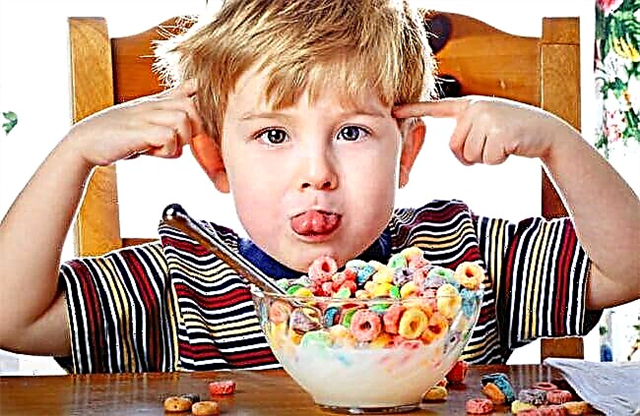Persimmon appears on store shelves in the fall and almost immediately becomes one of the sales leaders. This is not surprising - the fruit is not only very tasty, but also healthy, including for children. Despite this, you should not rush to introduce your baby to a new product.

Persimmon can be both harmful and beneficial for the baby.
The benefits of persimmon for children
In total, there are about 500 different varieties of persimmon. The main difference between the fruit and the same apples is the increased content of dietary fiber.
The orange color of persimmons is given by the bioflavonoids included in its composition, which not only strengthen the walls of blood vessels, but also improve the process of hematopoiesis. The fruit contains a large amount of vitamin A, which is involved in many processes and is very useful for the growth of nails, hair, vision. In addition, the product contains vitamins of groups B, C, E, PP and folic acid. Berry pulp contains such useful components as iodine, manganese, zinc, magnesium, calcium, as well as some other trace elements and organic acids.
The abundance of vitamins and their optimal ratio help to significantly increase children's immunity and quickly cope with the infection. In winter, it is especially important to give persimmon to children. In its ability to increase resistance to colds, the fruit is comparable to raspberry jam and honey.
Persimmon has a slight diuretic effect, which has a beneficial effect on the kidneys and urinary system of young children.
Important! The composition of persimmon fruits contains tannins that help with diarrhea. Actually, because of them, the fruit is not recommended for children suffering from constipation.
Nutritional value
The persimmon contains a large amount of carbohydrates, its nutritional value is about 120 kcal per 1 fruit. For 100 grams of products, there are:
- carbohydrates - 33 g;
- proteins - 0.8 g;
- fats - 0.4 g;
- water - 64 g.
Important! Due to its high sugar content, persimmons should never be given to children with diabetes of any type.
How to choose a persimmon
It is rare for a child to agree to eat fruit that knits in their mouth. Therefore, the choice of persimmon should be approached very meticulously. Ripe persimmons, regardless of the variety, are usually sweet and tasty. Experts recommend paying particular attention to the following points when choosing a product:
- Carefully examine the fruit leaf. If it is green, then the persimmon will have an astringent taste because it is not yet ripe. The leaf should be dry.
- A fully ripe fruit has stripes or small black marks on the skin near the stem.
- Persimmon varieties that are flattened or heart-shaped are usually not knitted.
- Hard persimmons are more likely to be unripe, as well as yellow-skinned fruit (ripe fruit is usually orange).
- If the fruit has large black spots, it is better not to buy it. There is a chance that it is frozen or spoiled.

Persimmons for feeding a child must be very ripe and juicy
When to introduce persimmons into complementary foods
Many parents wonder at what age a persimmon can be given to a child. There is no consensus on this issue. The points of view of specialists differ in everything, except that, if there are doubts whether it is possible to give a persimmon to a baby, the answer will be unanimously negative.
Is it possible for a persimmon for a child under one year old
You should not rush to acquaint the child with persimmon. The optimal time for adding fruit to the diet is 2-3 years. A one-year-old child or toddler who is ten months old is more likely to give an allergic reaction to the product. Many believe that a negative answer to the question of whether persimmon is possible for a 10 month old baby is associated with probable interruptions in the work of the intestines. Still, there are exceptions to each rule.
Those parents who adhere to pedagogical complementary foods may well, when the baby is one year old, offer him a fruit in a microscopic dose and follow the reaction of the body.
The opinion of Dr. Komarovsky
The famous doctor Komarovsky does not recommend feeding a child with persimmon until three (in some cases, up to five) years. In particular, you should not rush in if the baby initially has problems with the work of the gastrointestinal tract in general and the intestines in particular. It is better to start acquaintance with the product with thermally processed or dried fruits - in this form, the fruit in extremely rare cases causes an allergic reaction.
Complementary foods for a one-year-old child
If parents, in search of an answer to the question of at what age a persimmon can be given to a child, nevertheless decided to hurry up, to acquaint the baby with a useful, but problematic fruit should be very carefully.
How often to give
Often giving persimmon to babies is not worth it. If the acquaintance with it went well and without accompanying problems, it is allowed to include the fruit in the menu no more than once a week.
Important! Before offering persimmons to a small child, parents are advised to try the fruit themselves. It can be spoiled or astringent. In both cases, children's reactions can be unpredictable.
In any form
Persimmon for a child who is not yet a year old is best added to porridge in a grated form. The crumb will be able to cope with fresh fruit, if it is previously peeled and cut into small slices.

Persimmon can be added to any baby porridge
Important! After the child eats the fruit, it is recommended to brush his teeth or rinse his mouth. Due to the high sugar content in persimmons, there is a high risk of tooth decay.
Number
Having answered for themselves the question of when it is already possible to give persimmons to the child, in favor of an early age, parents should introduce a new complementary food with maximum accuracy. For the first feeding, it is recommended to make a choice of the sweetest variety "Korolek", to take a ripe or even slightly overripe fruit. When you meet, you need to give the baby no more than 10 g of pulp and observe the reaction of the body over the next three days. If there were no problems, next time you can increase the serving to one tablespoon, gradually bringing the amount to 50 grams. Whole fruit weighing about 150 grams should only be offered to older children.
What can be combined with
Persimmon goes well with various cereals. You can just take a small piece, grind and add to the dish. It can be semolina, millet, rice, oatmeal or any other porridge. For older children, persimmon can be added not in the form of mashed potatoes, but in small pieces.
Important! Since the calorie content of the fruit is high, it should not be consumed at the same time as protein meals: meat or fish. It is best to treat your baby to persimmon a couple of hours after breakfast or lunch.
Possible problems
Since any sort of persimmon is a heavy food for children's delicate digestion and takes a long time to digest, its excessive consumption can cause constipation. Do not forget that persimmon can "glue" the contents of the intestines and provoke obstruction. If this happens, it is very important to seek medical attention in a timely manner. Otherwise, the consequences will be the most unpredictable.
Eating persimmons on an empty stomach is strongly discouraged. This can provoke the formation of stomach stones. Also, babies should refrain from fruit after any surgical operations.
Signs of allergies
All yellow and orange fruits are strong allergens. Persimmon is no exception to the general rule. So the recommendation to give fruit in a minimal amount is also carefully connected with this. Every time you treat a child with a fetus, you should carefully monitor its condition - sometimes allergies develop unexpectedly and to foods that were previously in the diet (possibly in smaller quantities).

Persimmon allergy can manifest itself in different ways
Allergy to persimmon in a young child can have one of the following manifestations:
- rashes;
- itchy skin;
- increased body temperature;
- redness of the skin.
As soon as you notice any of the listed symptoms, it is recommended to immediately show the child to the pediatrician in order to completely eliminate the likelihood of negative effects on the body of the exotic fruit. Most often, an allergic reaction to persimmons occurs in sickly children with reduced immunity. Most importantly, the symptoms may not appear immediately after eating the fruit, but after a while.
If you process persimmons thermally (boil or at least scald with boiling water), the risk of allergies will be significantly reduced. In addition, eating dried fruits reduces the likelihood of a reaction. Although in the case of persimmon, this will be quite problematic.

Children especially love chocolate persimmons.
At what age to start feeding a child with such an ambiguous fruit as persimmon is a personal matter for parents. You need to act as carefully as possible so as not to harm the baby with your rash actions. If there is no special need, it is better to take your time and wait until the child grows up. After three years of age, there will definitely be more benefits from persimmon than harm.



